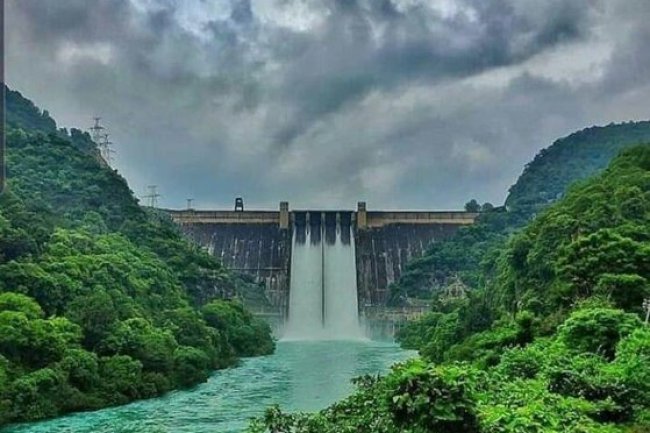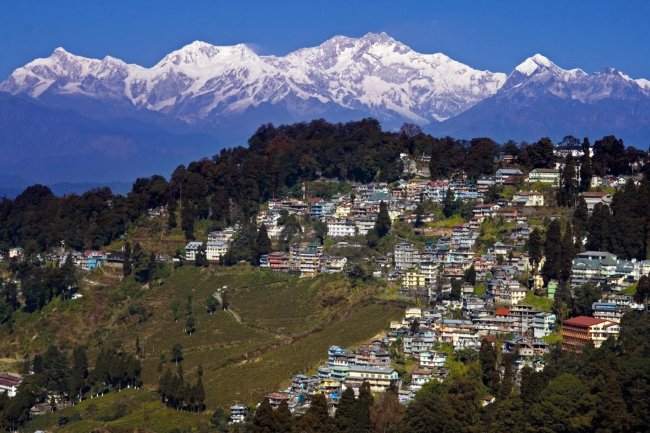Delhi Places | For Tourist
Delhi Place Like - 1. India Gate 2. Red Fort 3. Bangla Sahib 4. Lotus Temple 5. Jama Masjid 6. Akshardham 7. Qutub Minar 8. Rashtrapati Bhavan 9. Jantar Mantar 10. Agrasen Ki Baoli
Delhi, India's capital city, is a bustling metropolitan hub with a rich, vibrant culture and heritage. With its varied architecture, cultural diversity, and historical monuments, Delhi is a city that captivates visitors with its unique charm and energy.
Delhi is home to a wide array of architectural wonders. From the imposing Red Fort and Qutub Minar to the Lotus Temple and Akshardham Temple, Delhi is a treasure trove of architectural marvels. The city also has a number of ancient monuments like the Jama Masjid, Agrasen ki Baoli which are a must-visit for anyone looking to explore Delhi.
Delhi's culture is a blend of many different influences. There are numerous festivals and events throughout the year that reflect the culture of the city. From the vibrant Holi festival to the colorful Diwali celebrations, Delhi's culture is a feast for the senses. The city also has a wide array of culinary delights, ranging from traditional North Indian fare to international cuisines. The streets of Delhi are lined with roadside eateries and bustling food markets, making it easy to satisfy any craving.
Delhi is a vibrant and diverse city that offers something for everyone. From its cultural attractions to its culinary delights and shopping opportunities, Delhi is sure to delight anyone who visits.
1. INDIA GATE
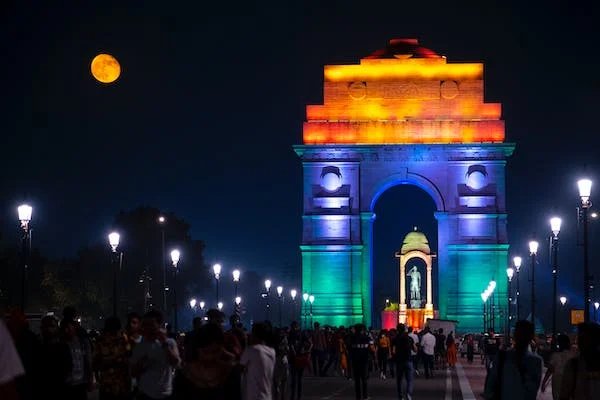
India Gate is a war memorial located in New Delhi, India, dedicated to the 70,000 soldiers of the British Indian Army who lost their lives while fighting for the British Raj in World War I and the Third Anglo-Afghan War. It is a popular tourist attraction and serves as a central focus for national celebrations. The India Gate is flanked by the Rashtrapati Bhavan (President's House) to the north and the cantonment area of New Delhi to the south. The memorial consists of a 42-meter (138 feet) tall sandstone archway and is located astride the Rajpath, which was built in 1931. India Gate is also the site of India's Tomb of the Unknown Soldier, known as the Amar Jawan Jyoti. The names of more than 70,000 Indian soldiers who died in the war are inscribed on the walls of the gate. The India Gate is considered to be one of India's most iconic landmarks and is a popular tourist destination. Firstly, it is a prominent landmark of the city of New Delhi and is visible from a great distance. Secondly, it is a popular tourist destination, with visitors coming to see the impressive architecture and the large number of soldiers who are stationed at the gate. Thirdly, it is a popular spot for meetings and events and is also used as a filming location for a number of Indian movies and TV shows. Finally, it is also a popular place to eat, with many people visiting the gate for its delicious food.
2. RED FORT
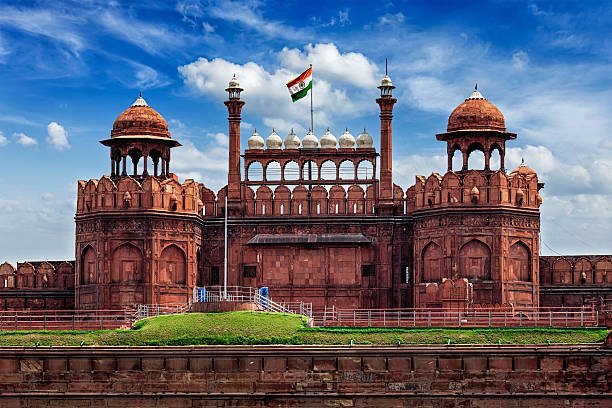
The Red Fort, also known as the Lal Qila, is a majestic fort located in Delhi, India. It was built by Mughal Emperor Shah Jahan between 1639 and 1648, and it is considered to be one of the most beautiful and impressive monuments of the Mughal era. The red sandstone walls of the fort, built along the banks of the Yamuna River, stretch for 2.5 kilometers (1.5 miles) and reach a height of 33 meters (108 feet). The Red Fort was the main residence of the Mughal emperors from 1648 until 1857 when the British took control of India. The fort was the symbolic center of Mughal rule and the site of celebrations and ceremonies, including the coronation of Emperor Aurangzeb in 1659. Inside the Red Fort, visitors can explore a number of impressive structures, including the Diwan-i-Khas (Hall of Private Audience), the Diwan-i-Aam (Hall of Public Audience), the Moti Masjid (Pearl Mosque), the Hayat Baksh Bagh (Life-Giving Garden), and the Rang Mahal (Palace of Color). The fort also contains a number of other monuments, such as the Hammam (bathhouse) and the Shahi Burj (Royal Pavilion). The Red Fort is a testament to the grandeur of the Mughal Empire and the beauty of Mughal architecture. Its walls are a reminder of the power and wealth that the Mughals held in India, and it is an important symbol of India’s independence. The fort is one of the most popular tourist attractions in Delhi, and it is a UNESCO World Heritage Site.
3. BANGLA SAHIB
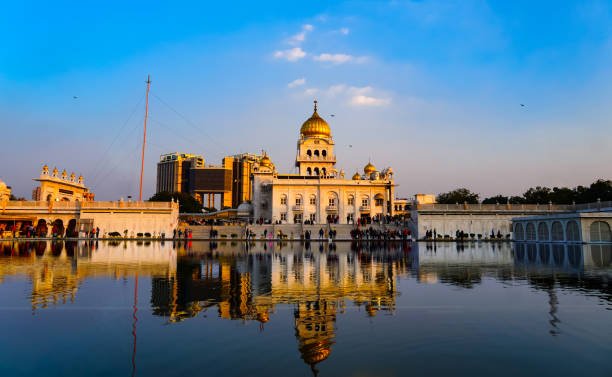
Bangla Sahib is a prominent Sikh temple in Delhi, India. It is one of the most important pilgrimage sites for Sikhs around the world. This revered temple is dedicated to the 8th Sikh Guru, Guru Har Krishan. The name 'Bangla Sahib' is derived from the Hindi words ‘Bangla’ meaning ‘house’ and ‘Sahib’ meaning ‘master’. The temple is also known as ‘Gurdwara Bangla Sahib’, meaning the ‘house of the master’. The temple is an important part of Sikh history and culture, having a deep connection with Guru Har Krishan.
The temple was built in 1783 by Raja Jai Singh of Amber, who was a devotee of Guru Har Krishan. The temple is one of the oldest in Delhi and is renowned for its unique architecture. It has a marble courtyard, surrounded by a white marble building with a gold dome. The temple also has a large pool of holy water called the ‘Sarovar’, which is believed to have healing powers. Inside the temple, there are many shrines dedicated to the Sikh Gurus. There is also a shrine dedicated to Guru Har Krishan, where devotees offer prayers and pay homage to him.
A temple is a popular place of pilgrimage for Sikhs from all over the world. Hundreds of devotees visit the temple.
4. LOTUS TEMPLE
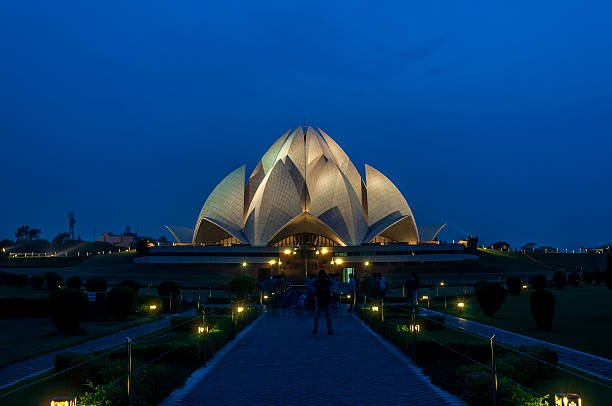
The Lotus Temple, located in Delhi, India, is a Bahá'í House of Worship that was completed in 1986. It is notable for its flowerlike shape, which is said to symbolize the oneness of all religions. The temple serves as a place of worship for people of all faiths and backgrounds. It has become one of the most visited buildings in the world and is known for its peaceful atmosphere and beautiful architecture. The design of the building was inspired by the lotus flower, which is a symbol of peace and harmony in many Eastern religions. The central hall of the temple is surrounded by nine pools of water, and its white marble walls are inscribed with verses from sacred scriptures of all major religions. The entire structure is said to represent the divine unity of all religions, and its open design encourages visitors to experience the oneness that lies within each and every one of us.
The Lotus Temple has become a popular tourist attraction in India, and it is visited by millions of people each year. Many of these visitors come to experience the peace and beauty of the temple, while others come to take part in religious ceremonies and services. The temple also serves as a venue for various events, such as concerts, yoga classes, and seminars.
The Lotus Temple is a place of peace and harmony, and its beauty and serenity provide a tranquil refuge from the hustle and bustle of everyday life. It is an ideal place to come and meditate, reflect on one's faith, and find spiritual renewal. The temple helps to break down barriers between different religions, cultures, and backgrounds and encourages visitors to embrace the oneness of the human spirit.
5. JAMA MASJID

Jama Masjid is a mosque in Delhi, India. It is one of the largest and oldest mosques in India and is the final resting place of the Mughal Emperor Shah Jahan. Built between 1644 and 1656, the Jama Masjid is a beautiful example of Mughal architecture.
The mosque is located in Old Delhi, on a hill that overlooks the city. It is a large open courtyard surrounded by four grand red sandstone minarets and a large central dome. The interior is decorated with marble and intricately carved stonework. The large courtyard can accommodate around 25,000 worshippers, and it is also used for religious ceremonies and festivals.
The Jama Masjid is a popular tourist attraction in Delhi and is a must-visit for anyone interested in Indian history and culture. The mosque is open to visitors of all religions, and visitors are welcome to take part in the prayer services or just admire the beautiful architecture.
The Jama Masjid is an important landmark in the history of India, and it is a symbol of the country’s rich cultural heritage. It is a reminder of the great Mughal Empire and its contribution to India’s history. Visiting the Jama Masjid is a great way to learn about the history and culture of India, and to appreciate the beauty of Mughal architecture.
6. AKSHARDHAM
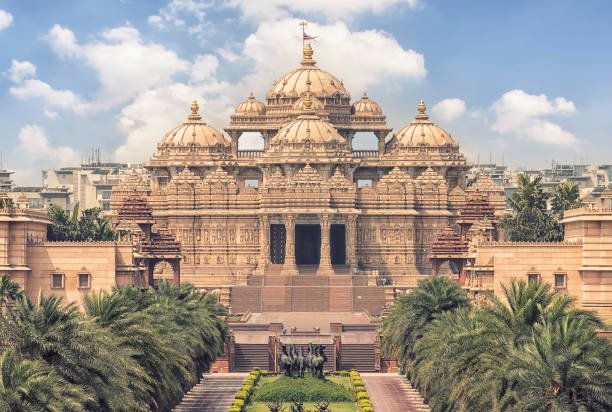
Akshardham is a large Hindu temple complex located in New Delhi, India. Built-in 2005 by the Swaminarayan sect of Hinduism, Akshardham is one of the grandest Hindu temples in India. It is a massive structure, covering an area of 86 acres and rising to a height of 141 feet.
The architecture of the complex is based on the Indian architectural principles of Vastu shastra and Pancharatra shastra. It is made up of ornately carved stones, marble, and bronze elements. The complex includes many unique features, such as an 11-foot bronze statue of Swaminarayan and a large garden full of fountains and sculptures. Inside the complex, there are several exhibits and attractions, such as a multimedia show, a musical fountain, and a sailing boat ride. There is also a large visitor’s center where guests can learn more about the temple and its history. The Akshardham complex also houses a large library with more than 10,000 books and manuscripts on religion, philosophy, and culture.
Visitors to the complex can also take part in a number of activities and spiritual programs. The temple’s devotionals include daily aarti, bhajans, and other forms of ancient sacred music. There are also lectures, meditation classes, and workshops on various philosophical and spiritual topics.
The Akshardham complex is a vibrant place full of life and culture. It is a unique and special place for those looking for a spiritual experience. Whether it’s admiring decorative artwork and sculptures or taking part in spiritual activities, Akshardham is likely to leave everyone with a sense of peace, joy, and inner well-being.
7. QUTUB MINAR
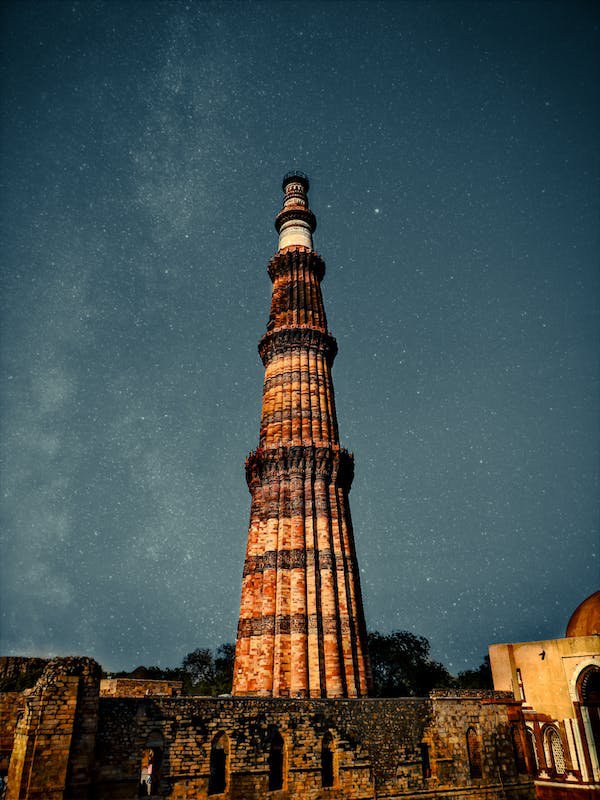
The Qutub Minar is a towering tower located in Delhi, India, and is a UNESCO World Heritage Site. It stands approximately 73 meters tall and is the world’s tallest brick minaret. The tower was built in the 12th century by the Delhi Sultanate and is considered to be one of the finest examples of Indo-Islamic architecture.
The Minar was built by Qutub-ud-din Aibak and is located in the heart of the Qutub complex. The complex also includes Alai Darwaza, the Iron Pillar of Delhi, Quwwat-ul-Islam Mosque, and Iltumat-ud-Din’s Tomb. The tower was built to commemorate the victory of Muhammad of Ghor over the Rajputs in 1193 and is believed to have been completed by his successor Iltutmish in 1220. The Qutub Minar consists of five stories each of which is decorated with intricate carvings, arches, and ornamental designs. The towers are built with red and buff sandstone which gives it a unique look. The fourth story of the minar has a balcony that was used to make important announcements to the people of Delhi. The top of the minar also has a balcony from where one can get a stunning view of the city.
The Qutub Minar is a part of the Qutub complex and is an important attraction for tourists visiting Delhi. It stands as a testament to the legacy of Indo-Islamic architecture in India and is one of the most iconic structures in the city.
8. RASHTRAPATI BHAVAN
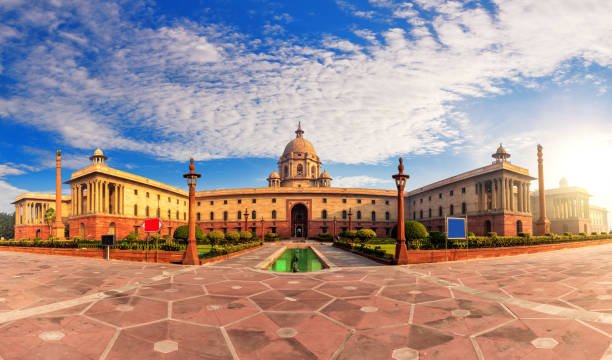
Rashtrapati Bhavan is the official residence of the President of India, located in New Delhi. It is one of the most iconic buildings in India and is a symbol of the country’s rich history and culture.
The building was designed by the British architect Edwin Lutyens and was completed in 1929. It is a sprawling complex of 340 rooms spread over four floors and covers an area of 200 acres. The building is made of red sandstone and is surrounded by lush gardens and lawns. The main building of Rashtrapati Bhavan is the Durbar Hall, which is used for state functions and ceremonies. It is a grand hall with a high ceiling and is decorated with intricate carvings and paintings.
The hall is also used for hosting foreign dignitaries and heads of state. The building also houses the President’s office, the President’s Secretariat, and the President’s Bodyguard. The President’s Bodyguard is a ceremonial unit of the Indian Army and is responsible for the security of the President. Rashtrapati Bhavan is a popular tourist destination and is open to the public on certain days of the year. Visitors can explore the building and its grounds, and take in the grandeur of the building. Rashtrapati Bhavan is a symbol of India’s rich history and culture, and is a reminder of the country’s commitment to democracy and progress.
It is a must-visit destination for anyone visiting New Delhi.
9. JANTAR MANTAR
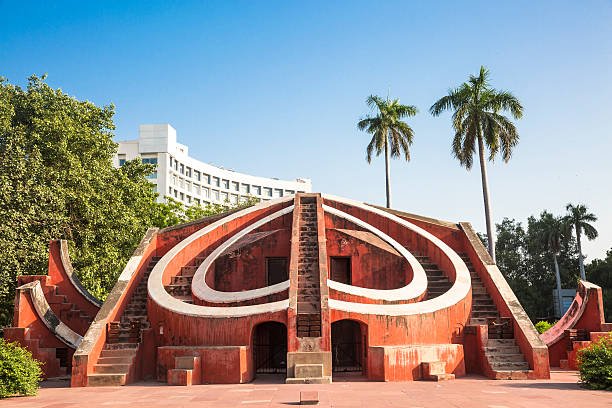
The Jantar Mantar in Delhi is the largest and best preserved of the five observatories. It consists of fourteen major geometric devices for measuring time, predicting eclipses, tracking stars in their orbits, and determining the declinations of planets. The most impressive of these instruments is the Samrat Yantra, a giant sundial that is 70 feet high and is accurate to within two seconds. The Jantar Mantar is a popular tourist attraction in Delhi and is a UNESCO World Heritage Site. It is also a popular spot for photographers, who come to capture the unique architecture of the observatory. The Jantar Mantar is a reminder of the scientific achievements of the Mughal Empire and its rulers. It is a testament to the advanced knowledge of astronomy and mathematics that was available in India during the 18th century. It is also a reminder of the importance of science and technology in the development of a nation.
10. AGRASEN KI BAOLI
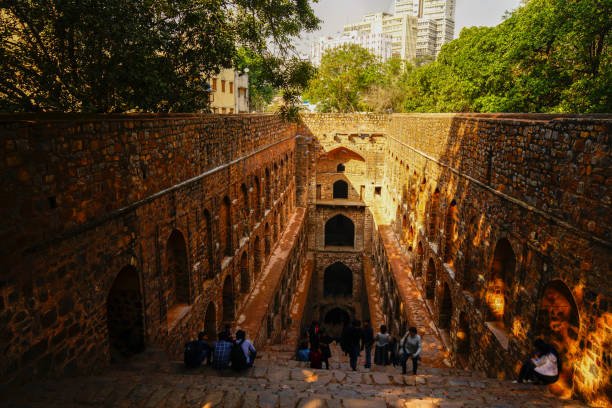
Agrasen Ki Baoli is a historical stepwell located in the heart of New Delhi, India. It is believed to have been built by Maharaja Agrasen during the Mahabharata era.
The stepwell is a popular tourist attraction and is known for its unique architecture and historical significance. The stepwell is a three-storey structure with a series of steps leading down to the water. The steps are made of red sandstone and are lined with arches and pillars. The walls of the stepwell are decorated with intricate carvings and sculptures. The stepwell is also home to a number of shrines dedicated to various Hindu gods and goddesses. The stepwell is believed to have been built to provide water to the people of Delhi during times of drought. It is also said to have been used as a place of refuge during times of war.
The stepwell is now a popular tourist destination and is visited by thousands of people every year. The Agarsen Ki Baoli is a great example of ancient Indian architecture and is a reminder of the rich cultural heritage of India. It is a must-visit destination for anyone looking to explore the history and culture of Delhi.
What's Your Reaction?








